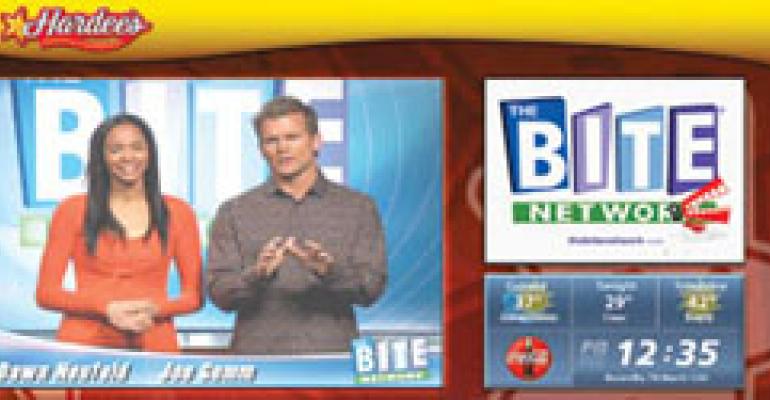Along with whatever else they remember about dining out this year, many consumers may recall 2009 as the year colorful, kinetic and ear-grabbing multimedia programming replaced innocuous background music in their favorite foodservice establishment.
From now-sounds-punctuated slide shows of food, beverages, popular activities or cultural icons, to full-motion video of host-brand commercials, breaking news or movie trailers, digital content increasingly is playing on flat-panel displays in restaurants, food courts and coffee bars.
Some operators say these image-based infotainment platforms fool customers into feeling as if their wait times are shorter or inspire them to buy more or more margin-friendly “specials.” Others indicate they are changing the business dynamics of in-store guest engagement.
“The simple idea is to try to maximize the customer experience” and “see if consumers want to be communicated with using relevant, short-form entertainment,” Brad Hunter, western division marketing manager for McDonald’s Corp of Oak Brook. Ill., says of goals for the “McDonald’s Channel.”
That channel is “in test” at single units in Las Vegas and Los Angeles and delivers two-to-three-minute snippets from high-definition educational TV shows and location-relevant weather and other information. McDonald’s commercials, product shots and crawling text messages as well as promotional materials from content providers also are part of the three-hour looping content package delivered and managed by partner firms.
McDonald’s is using a proprietary alliance with outside firms for its so-called out-of-home multimedia network. Many chains testing these waters, however, are agreeing to share customer eyeballs with third-party digital content and advertising aggregators–and their sponsors or advertisers–in exchange for in-restaurant display hardware and programming for little or no cost. Some aggregators bundle a restaurant chain’s promotional materials in with standard programming, handle all maintenance, and share sponsor or advertising fees with the foodservice host.
The business model of content aggregation and distribution services that share revenues is more appealing to some foodservice leaders than the approach of fee-based canned-music or rights-licensing organizations. Among them is Andrew Puzder, chief executive of Carl’s Jr. and Hardee’s parent CKE Restaurants Inc. of Carpinteria Calif., who voiced the obvious upside to dealing with such multimedia firms at a recent industry gathering by noting, “They pay you.”
One of the multimedia aggregating services dealing with CKE says it will be in more than 1,000 foodservice establishments by the end of the 2009’s first quarter. Its website shows content from a number of chains, including Captain D’s, Del Taco and Taco Bueno. A competing aggregator working with Noah’s New York Bagels, The Coffee Bean & Tea Leaf, Jack in the Box, Robeks, Tully’s Coffee and Juice it Up!, among others, says it is already in 1,000 locations and growing.
Not even drive-thru patrons can escape the growth in multimedia marketing technologies. Tim Hortons of Oakville, Ontario, Canada, has digital-content-fed display screens in the drive-thru lanes, as well as counter areas, of its 2,900 Canadian outlets that underscore promotions and show eye-catching food images.
Some operators piggyback off the in-store entertainment and marketing efforts of others, including Wendy’s International Inc. of Dublin, Ohio. In one case, interactive Wendy’s advertising was presented to users of touch screen digital “juke box” music devices in 5,100 bars and nightclubs within a mile of a Wendy’s restaurant. Bar patrons who touched the ads were shown a sizzling burger and, if hungry, could call up the address of the chain’s nearest unit for an engage-inform-and-capture cycle that Wendy’s representative Bob Bertini acknowledges, “We’re really excited about.”




